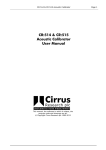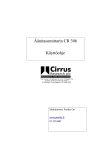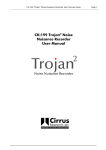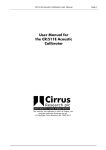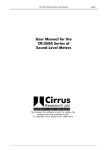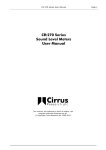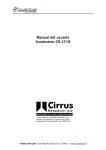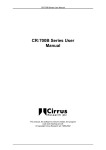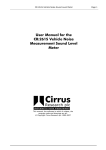Download MK Sound BE-65 User manual
Transcript
CR:306 Sound Level Meter User Manual User Manual for the CR:306 Sound Level Meter This manual, the software to which it relates, the program code and drawings are all: © Copyright Cirrus Research plc 1989-2013 Page 1 Page 2 CR:306 Sound Level Meter User Manual The content of this manual, any illustrations, technical information and descriptions within this document were correct at the time of going to print. Cirrus Research plc reserves the right to make any changes necessary, without notice, in line with the policy of continuing product development and improvement. No part of this publication may be duplicated, reprinted, stored in a data processing system or transmitted by electronic, mechanical, photographic or other means, or recorded, translated, edited, abridged or expanded without the prior written consent of Cirrus Research plc. No liability is accepted for any inaccuracies or omissions in this manual, although due care has been taken to ensure that it is complete and as accurate as possible. Accessories supplied by Cirrus Research plc have been designed for use with the instrumentation manufactured by Cirrus Research plc. No responsibility is accepted for damage caused by the use of any other parts or accessories. In order to take account of a policy of continual development, Cirrus Research plc reserves the right to change any of the information contained in this publication without prior notice. Produced by Cirrus Research plc, Acoustic House, Bridlington Road, Hunmanby, North Yorkshire, YO14 0PH, United Kingdom. © Copyright Cirrus Research plc 2013 Reference Number 08/13/CR306/02 Document Printing Date Monday, 19 August 2013 CR:306 Sound Level Meter User Manual Page 3 Overview. ..................................................................................................................... 4 First time use. .............................................................................................................. 4 CR:306 Instrument Check List ...................................................................................... 4 Instrument Controls ..................................................................................................... 5 Taking Measurements................................................................................................... 7 Fundamental precautions. ..............................................................................................7 Display and Indicators.................................................................................................. 8 Display.........................................................................................................................8 Indicator ......................................................................................................................8 Fitting a New Battery ................................................................................................... 9 Field Calibration ......................................................................................................... 10 Calibration Procedure ................................................................................................... 10 Technical Specification ............................................................................................... 11 Appendix 1 - CE Declaration of Conformity ................................................................. 12 Appendix 2 Acoustic Calibrator Operation. ................................................................. 13 Switching on the Calibrator ........................................................................................... 13 Permanent-on Mode ................................................................................................................ 13 Calibrating a Sound Level Meter. ................................................................................... 14 Background Noise ........................................................................................................ 14 Stabilisation ................................................................................................................ 14 Changing the Battery ................................................................................................... 15 Battery type. .............................................................................................................. 15 Specification. .............................................................................................................. 16 Technical Information .................................................................................................. 17 Free Field Correction .................................................................................................... 18 Microphone Correction Values ................................................................................................... 18 Example ................................................................................................................................ 18 Warranty Information. .......................................................... Error! Bookmark not defined. Cirrus Research Offices ......................................................... Error! Bookmark not defined. Page 4 CR:306 Sound Level Meter User Manual Overview. Thank you for purchasing the CR:306 sound level meter from Cirrus Research plc. This entry level meter is designed to be quick and simple to use when taking basic sound measurements and we are sure it will meet your requirements. The CR:306 is a general purpose digital sound level meter which meets the full requirements of IEC 61672 to Class 2. The instrument has 'F' (Fast) response and has both 'A' and 'C' frequency weightings. In addition facilities are provided to hold the maximum reading occurring throughout the measurement period. First time use. The CR:306 should be inspected for any signs of damage and also to ensure that all relevant accessories are present. Your CR:306 will have been supplied either as a single unit or as part of a full measurement kit, CK:306. CR:306 Instrument Check List The CR:306 Sound Level Meter is supplied with the following accessories as standard: CR:306 Class 2 Sound Level Meter UA:236 50mm wind shield Calibration Screwdriver User Manual Certificate of Calibration 1 x 9V Battery The CR:306 Sound Level Meter can also be supplied as a complete measurement kit, the CK:306, which includes a CR:514 Class 2 Acoustic Calibrator and a CP:65 carrying pouch. For further details of the options and accessories for the CR:306 Sound Level Meter, please contact your local representative. CR:306 Sound Level Meter User Manual Instrument Controls Page 5 Page 6 CR:306 Sound Level Meter User Manual CR:306 Sound Level Meter User Manual Page 7 Taking Measurements Before taking measurements, ensure the instrument has a new or highly charged battery fitted. The instrument is supplied with a battery but it is not fitted for transit. See page 9 for details of fitting and changing the battery. Turn the instrument on by moving the OFF/F slide switch to the F position: > OFF >F = Instrument is powered off. = Fast Time Weighting Allow the instrument to settle for 10 seconds before calibrating or taking measurements. Ensure the instrument is calibrated (see page 10 for details of calibration) Select the required Frequency Weighting using the A/C slide switch: >A >C = A-Weighting or dB(A) = C-Weighting or dB(C) Select the most appropriate range for the acoustic environment using the H/L slide switch: >L >H = Low Range (suitable for levels up to 100dBA) = High Range (suitable for levels over 65dBA) If the maximum exceeded level is required then press the MAX HOLD button for at least ½ second. Once released the text HOLD is illuminated in the top left of the instrument display. In this mode the highest measured sound pressure level is displayed. To turn off the maximum hold facility either press the MAX HOLD button again or turn the unit off. Fundamental precautions. This section contains some simple points that should be considered when using the CR:306 instrument: a) Allow the instrument to settle for 10 seconds after switching on before calibrating or taking measurements. b) Always check the battery before and after each measurement. The CR:306 monitors the battery continuously while operating. c) Ensure that the white MAX HOLD function is turned off when not required. If this is not done, the display will freeze the last reading and the word HOLD will be displayed on the top left of the LCD. Page 8 CR:306 Sound Level Meter User Manual d) Wherever possible, always check the instrument calibration before and after each measurement. e) Whenever the instrument is not to be used for a long period of time (> one month) then remove the battery completely. This action will prevent leakage damage. Display and Indicators Display The LCD display of the CR:306 is scaled in decibels, either 'A' or 'C' weighted, depending on the position of the A/C slide switch. There are indicators in the display as follows:Function Indicator Cause and Possible Action Low Battery LOWBAT Battery capacity low, replace battery Maximum Hold MAX HOLD The display is MAX, push MAX HOLD to reset Indicator There are also two status indications above the instrument display, these have the following functions: Function Indication Cause and Possible Action Under Range Green Light The sound level is below the current measurement range. Move the L/H slide to the L position. Overload Red Light The sound level is above the current measurement range. Move the L/H slide switch to the H position. CR:306 Sound Level Meter User Manual Page 9 Fitting a New Battery 1. Ensure the instrument is turned off before removing the battery cover. 2. Remove the battery cover. 3. The battery is made accessible by pressing the left hand side of the battery cover down slightly and then sliding it to the right. The spent battery can then be removed and disposed of safely. 4. A new battery, IEC 6F22 (NEDA 1604, PP3) can then be fitted. The battery can only be fitted in one orientation. 5. Replace the battery cover by sliding it back into place from right to left. Page 10 CR:306 Sound Level Meter User Manual Field Calibration It is vital that the calibration of ANY sound level meter is checked before and after each measurement. If this is done, it is reasonable to assume that the calibration during the measurement was correct. If this is NOT done, you will not subsequently be able to be certain that the instrument calibration was correct and you can never be certain the sound level was as measured. This process is commonly referred to as field calibration. The sound level meter is calibrated acoustically using an external reference, e.g the Sound Level Calibrator CR:514, which is placed over the microphone. The calibrator generates a stabilised Sound Pressure Level of 94dB (+- 0.3dB) at a frequency of 1kHz. Calibration Procedure 1. Ensure the batteries are fitted correctly and have sufficient power left. 2. Ensure the MK:268 microphone capsule is fitted correctly 3. Turn the instrument on with the following settings: OFF/F in the F position L/H in the L position A/C in the A position (This relates to Fast Time Weighting, Low Measurement Range and dB(A) Frequency) 4. Ensure the MAX HOLD function is not active. (The word HOLD is not displayed in the top left hand corner of the instrument display) 5. Attach the acoustic calibrator and turn it onto the 94dB output setting. An acoustic calibrator such as the CR:514 is suitable. 6. Using the provided calibration screwdriver, slowly adjust the CAL potentiometer until the instrument display reads 93.7dBA. (Turning the CAL potentiometer clockwise increases the displayed level whereas anti-clockwise reduces the displayed level) Note: Although the CR:514 Acoustic Calibrator has an output of 94dB, the pressure correction of the MK:268 microphone capsule is 0.3dBA. For this reason the CR:306 must be adjusted to give a reading of 93.7dBA. 7. The instrument is now calibrated. For details of the operation of the CR:514 and CR:515 Acoustic Calibrators, please refer to the information contained at the back of this manual. CR:306 Sound Level Meter User Manual Page 11 Technical Specification A full technical user manual, including mandated rating plate information is available upon request. Standardisation: IEC 61672-1:2002 Class 2 IEC 60651:1979 Type 2 I Measurement Range: 35dB(A) to 130dB(A) 40dB(C) to 130dB(C) Range Information: L (Low) = 35dB(A) to 100dB(A) > 100dB(A) = over range indicator H (High) = 65dB(A) to 130dB(A) < 65dB(A) = down range indicator > 130dB(A) = over load indicator Frequency Weighting: A & C-Weighting to IEC 61672-1:2002 Class 2 Time Weighting: Fast to IEC 61672-1:2002 Class 2 Time constant 125mS Display Functions: Normal (Sound Level), Maximum Hold Measurement Functions: LAF, LCF, LAFMax, LCFMax Display Flags: Over Load (Green Light) Under range (Red Light) Maximum Hold (HOLD) Low battery (LOWBAT) Reference Point: 94dB(A), 1000Hz on Low Range (L) Display: 3 ½ digit LCD, Update rate of 1Hz Resolution: 0.1dB Electrical Outputs: AC Out Max output = 2V, output impedance 600Ohm Power: 1 x 9V (6F22, PP3) External DC Power, 7V to 10V Microphone: ½” pre-polarised electret condenser type MK:268 Operating Temperature: -10°C to +50°C Storage Temperature: -20°C to +60°C Dimensions: Length 248mm, Width 66mm, Depth 30mm Weight: 227g (8oz) with battery Page 12 CR:306 Sound Level Meter User Manual Appendix 1 - CE Declaration of Conformity Cirrus Research plc Hunmanby UK CE Certificate of Conformity Manufacturer: Cirrus Research plc Acoustic House, Bridlington Road Hunmanby, North Yorkshire, YO14 0PH United Kingdom Telephone +44 1723 891655 Equipment Description The following equipment manufactured after 1st January 2007: CR:306 Sound Level Meter CR:514 Acoustic Calibrator CR:515 Acoustic Calibrator Along with their standard accessories According to EMC Directives 89/336/EEC and 93/98/EEC meet the following standards EN 61000-6-3 (2001) EMC : Generic emission standard for residential, commercial and light industrial environments. EN 61000-6-1 (2001) EMC : Generic immunity standard for residential, commercial and light industrial environments. Signed S. O′Rourke Director Dated 1st January 2007 CR:306 Sound Level Meter User Manual Page 13 Appendix 2 Acoustic Calibrator Operation. Switching on the Calibrator Press the Power Button on the end of the Calibrator to switch the unit on. The Indicator will illuminate to show that the unit is operating. The calibrator will automatically switch off after 5 minutes to preserve battery power. To switch off the calibrator manually, press the power button again and the indicator will extinguish to show that the unit is switched off. Permanent-on Mode For some applications there may be a need to have the calibrator switched on continuously. To allow for this, the calibrator can be turned on by pressing and holding the power button for three seconds. Release the button and the indicator will flash to show that the unit is in permanent-on mode. Press the power button to switch off the calibrator. Page 14 CR:306 Sound Level Meter User Manual Calibrating a Sound Level Meter. Push the microphone of the Sound Level Meter into the cavity at the end of the calibrator. Ensure the microphone is fully inserted into the cavity and is past the ‘O’ ring seals. The microphone should be parallel to the body of the calibrator. Also ensure that the small bleed-hole next to the microphone cavity is not blocked as this could cause damage to the microphone. Most modern Sound Level Meters have electronic calibration with the level adjusted automatically. Adjust the Sound Level Meter to the correct level where applicable. When correcting the value generated by the calibrator a correction for the type of microphone capsule may need to be applied (see Appendix 2) Background Noise In order for the calibrator to operate as intended, the ambient acoustic noise level should be no greater than 80dBA. Stabilisation In order for the sound pressure level and frequency to stabilise after switching the calibrator on when coupled to a microphone, a period of at least 3 seconds should be allowed before performing a calibration. CR:306 Sound Level Meter User Manual Page 15 Changing the Battery The CR:514 & CR:515 acoustic calibrators use a single 9v alkaline battery. This type of battery is known as 6F22 or NEDA 1604. It is also commonly known as PP3. 1. 2. Unscrew the screw holding the battery cover on, using a coin. The battery, type 6F22 (PP3) can now be eased out of its holder and replaced. The battery should be eased out terminal side first by pushing against the spring at the other end. Ensure that the battery is inserted with the correct polarity with the negative terminal at the contact with the larger cutout. Battery type. The battery should be an alkaline battery, not an ordinary dry cell. The battery is 9 volts when new and will operate the calibrator down to 6.4 volts. When the battery voltage is below 6.6 volts but above 6.4 volts, the power LED will flash to indicate that the battery voltage is low. When the battery voltage is below 6.4 volts the calibrator will not turn on. A discharged battery may allow switch-on but will soon drop in voltage and indicate low battery or switch off. Page 16 CR:306 Sound Level Meter User Manual Specification. Frequency 1kHz ± 1% Sound Level 94dB re 20μPa Standardisation CR:514 - IEC 60942:2003 Class 2 CR:515 - IEC 60942:2003 Class 1 Distortion Less than 2% Operating Humidity 25 to 90% Relative Humidity Operating Static Pressure 65 kPa to 108kPa Operating Temperature -10oC to +50oC Storing Temperature -20oC to +60oC Effective Volume 6.19 cm3 ± 0.2 cm3 Cavity Diameter 0.525 inch Battery 1 x 9v 6F22 (Neda 1604) Battery Life Approx 15 Hours Continuous Use Battery Voltage 9v Nominal (10v Maximum, 6.4v Minimum) Weight with Battery 185g Dimensions 135mm x Ø48mm CR:306 Sound Level Meter User Manual Page 17 Technical Information The normal mode of operation of the calibrator is with the unit switched on. When the LED indicates the unit is switched on this produces the greatest radio frequency emissions. The calibrator continues to function after exposure to contact discharges up to 4kV and air discharges up to 8kV, for both positive and negative voltages relative to earth ground. The calibrator conforms to IEC 60942:2003 for a modulated root-mean-square electromagnetic field strength of 10 V/m. The maximum susceptibility to power and radio frequency fields is with the cavity facing away from the emitter with the battery compartment facing the table, the antenna polarisation horizontal and the calibrator switched on. Page 18 CR:306 Sound Level Meter User Manual Free Field Correction When calibrating a microphone which is to be used for free field measurements, a small correction may be necessary to compensate for the difference between the microphone's free field response at 'zero degrees' or 'head-on' incidence and the pressure level generated by the calibrator. The correction is typically -0.3dB for ½ inch microphones (making the effective calibration level 93.7dB). The table below shows the correction values for the standard microphones of Cirrus Research plc. Calibration corrections are listed below for the Cirrus Research plc ½" Capsules and three microphone capsules commonly used in Calibration Laboratories: Microphone Correction Values Microphone Type Calibration Correction Effective Calibration Level MK:202 MK:215 MK:216 MK:226 MK:224 -0.3dB -0.3dB -0.3dB -0.3dB -0.3dB 93.7 93.7 93.7 93.7 93.7 B&K 4134 B&K 4180 B&K 4192 0dB 0dB 0dB 94.0 dB 94.0 dB 94.0 dB dB dB dB dB dB Example An example of the procedure used to calculate the value for an MK:224 microphone is shown below : Level = 94.0dB + Microphone Correction Level = 94.0dB + ( -0.3dB) Level = 93.7dB Different microphones will have different correction values. Please check the operation manual for the Sound Level Meter or microphone concerned for details. CR:306 Sound Level Meter User Manual Page 19 Warranty Information. 1. This document is a summary of the full warranty document and explains the Cirrus Research plc warranty in ordinary English; not in legal or complex terms. 2. The warranty covers any acoustic instrument such as a sound level meter, acoustic calibrator, real time acoustic analyser or personal sound exposure meter (dosemeter) manufactured by Cirrus Research plc after 1st September 2011. 3. The warranty covers all faults on the instrument except the microphone for the period defined in para (4) below, including minor accidental damage except to the microphone. 4. The period of the warranty is 2 (two) years or 104 weeks from the date of purchase as a new instrument from Cirrus Research plc or their formally approved distributors OR 130 weeks from the date the instrument passed its final manufacturing inspection at Cirrus Research plc - whichever is the shorter. 5. Any rechargeable battery only has the battery manufacturer’s one year warranty however there will be a reduced charge for replacing rechargeable batteries during the annual “Routine Verification” process. (Commonly referred to as “Annual Recalibration”) 6. No warranty is offered for used equipment unless a special arrangement is made and a written confirmation of the warranty is given by Cirrus Research plc. 7. On completion of the routine verification by Cirrus Research plc, the instrument will automatically be given an additional free one year warranty. 8. There will be a charge for this routine verification and the price is published in the Service Price List. 9. The customer is responsible for all shipping, duty and other charges relating to the servicing and calibration of the instruments. 10. It follows that should the instrument be routinely verified by Cirrus Research plc every year, the warranty is effectively continuous to a maximum of 15 (fifteen) years from the date of purchase. 11. Cirrus Research endeavours to ensure stocks of instrument components for the full fifteen year period but do not guarantee to do so as certain components do become obsolete or discontinued. 12. If a sub-component becomes obsolete and stocks are depleted then Cirrus Research will endeavour to facilitate a repair but will not offer the same length guarantee. 13. In the event of any dispute on the terms of the warranty Cirrus Research plc will accept pendulum arbitration by the United Kingdom Institute of Acoustics Ltd. 14. The warranty does not in any way reduce any legal right of the buyer or user of the sound level meter; it is in addition to all legal rights determined by the European Union. Page 20 CR:306 Sound Level Meter User Manual Cirrus Research Offices The addresses given below are the Cirrus Research plc offices. Cirrus Research plc also have approved distributors and agents is many countries worldwide. For details of your local representative, please contact Cirrus Research plc at the address below. Contact details for Cirrus Research authorised distributors and agents are also available from the Internet Web site at the address shown below. Spain Main Office Cirrus Research plc Acoustic House Bridlington Road Hunmanby North Yorkshire United Kingdom YO14 0PH Telephone: Fax: E-mail: Web Site: +44 (0)1723 891655 +44 (0)1723 891742 [email protected] www.cirrusresearch.co.uk Germany Cirrus Research plc Deutschland Arabella Center Lyoner Strasse 44 – 48 D-60528 Frankfurt Germany Tel: +49 (0)69 95932047 Fax +49 (0)69 95932049 Email: Web: [email protected] www.cirrusresearch.de France Cirrus Recherche Ltd 40 Bis Avenue Gabriel Fauré 09500 Mirepoix France Tel: +33 5 61 67 40 01 Fax: +33 5 61 67 40 56 Email: [email protected] Web: www.cirrusresearch.fr CIRRUS RESEARCH S.L. Travessera de Gracia, 62 4° 7ª 08006 Barcelona SPAIN Tel: Email: Web: (34) 933 622 891 [email protected] www.cirrusresearch.es Cirrus Environmental Unit 2 Bridlington Road Industrial Estate Hunmanby North Yorkshire YO14 0PH United Kingdom Tel: +44 (0) 1723 891722 Email: [email protected] Web: www.cirrus-environmental.com




















